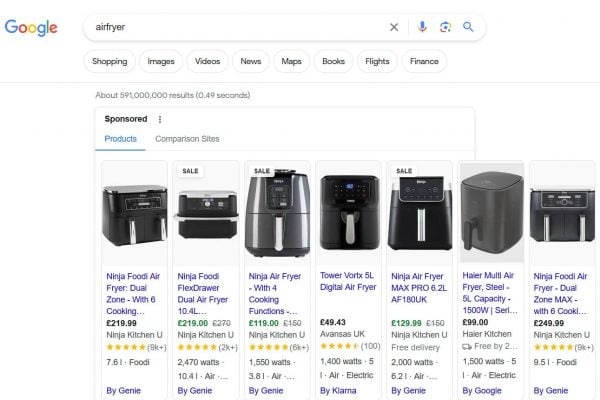 Matthew Ogborne, Co-Founder of UnderstandingE.com offered to put some advise together regarding Google’s latest mobile updates. It’s not something we’ve covered on Tamebay, so many thanks Matt and here’s what he had to say:
Matthew Ogborne, Co-Founder of UnderstandingE.com offered to put some advise together regarding Google’s latest mobile updates. It’s not something we’ve covered on Tamebay, so many thanks Matt and here’s what he had to say:
Mobilegeddon – Google’s Mobile Update
Howdy,
The latest Google search update has been dubbed “Mobilegeddon”.
This is one of the clearest announcements from Google that by April 21st that “mobile-friendliness” will start to be used as a “significant” ranking signal for websites.
Let’s face it, when we’re using our phones/pads, the last thing we want to be doing is pinching & zooming around a page. Google recognises that and hence this update, sites that are mobile-friendly will start to be ranked more favourably compared to non-mobile optimized sites.
To be more specific, this update will affect:
- Only search rankings on mobile devices
- Search results in all languages globally
- And applies to individual pages, not entire websites
If we consider that only 50% of sites are mobile optimized and 50% of all local searches are made on mobile devices, the impact of this is going to be huge, especially in eCommerce.
How can I check if my site is affected?
Right, let’s get down to the nitty-gritty.
Checking if your website is easy. Enter your website URL into the link below:
https://www.google.com/webmasters/tools/mobile-friendly/
It takes about 20-30 seconds for your site to be tested and ideally you want to be seeing a message like this:

However, what you really don’t want to be seeing is a message like this:

For more advanced users, there is a new “Mobile Usability Report” available in Google Webmaster tools. This will give you a breakdown of specific errors for your site and you can check your status here: https://www.google.com/webmasters/tools/mobile-usability
If your website came back as being “Awesome! This page is mobile-friendly” then it’s likely any additional errors for specific pages are going to be few & far between. You’ll already being using a responsive website design and any additional errors will be picked up in the mobile usability report in Webmaster tools.
However… let’s consider you have seen a red warning message and lots of red crosses 🙁 let’s cover a couple of common questions you may have.
I am affected, what’s the impact going to be like?
For Google to use the word “significant” you should take immediate attention of this update.
Personally I can’t remember when they last used such strong terms as this for an update that would update normal websites (spam & naughty practices yes, but general updates no).
The thing to note about this update is that it’s going to affect customers that are already on their mobile devices when they’re making searches. So if your site is not mobile friendly, then the chances of your site appearing at the top or near the top are going to be a lot less than what they have been to date.
Responsive what?
 Roll back 5 years and having a separate mobile site was the norm. It was the best way at the time of handling mobile site visitors by serving them an optimized site that was designed for smaller screen sizes.
Roll back 5 years and having a separate mobile site was the norm. It was the best way at the time of handling mobile site visitors by serving them an optimized site that was designed for smaller screen sizes.
However today, web browsers have caught up.
Thanks to a special option in CSS called @media the industry standard is now to have one website that works on multiple devices, where the site resizes automagically based upon the customers screen size.
Note: “CSS” means “Cascading Style Sheet”, this is what web designers use to make websites look pretty. For example you’re most likely reading this on the Tamebay site and the title of this section “Responsive what?” is in orange. CSS made this text orange. The CSS @media query means that web designers can change the site layout based upon screen size.
An Example
The best way of showing you how this is works, is to open up UnderstandingE.com and then resize your browser window making it smaller and larger.
You’ll notice that the website retains its look and feel, but the site page adapts to your screensize. And if you opened that link up on a mobile phone or pad, then rotate your device and see it expand and contract depending on the orientation of the device.
This is a “responsive” website design in action. One website design that adapts to different screen sizes.
I am using a website built on XYZ, what are my options?
Now that we know that this update is pretty important, that web browsers and web designers have caught up, let’s take a different direction and focus on solving the problem for you without it costing you the GDP of a small country in redesign fees.
To help you, I’ve listed a number of common website platforms and my personal suggestions on themes that can be bought off the shelf and adapted.
None of these cost more than $100/£65.
Magento
 You’ll most likely know that I’m a big fan of Magento as it can be used to list onto eBay & Amazon using the M2E Pro extension.
You’ll most likely know that I’m a big fan of Magento as it can be used to list onto eBay & Amazon using the M2E Pro extension.
However just like any of the other shopping cart platforms that follow there are lots (and I mean lots!) of pre-existing website designs that you can buy off the shelf and adapt to your own needs.
For Magento, my personal favourite responsive website theme has to be “Ultimo“.
It costs $99/£65 and has been purchased over 11,000 times.
It’s a theme that I have used myself personally numerous times. Support is included and it’s the same theme that we based our “Designing a Responsive Magento website for $99” video course on.
The sheer amount of design options included in this theme is “sick”. Enough make a “standard” design package feel ill in envy. Selecting your site design colours is as easy as a colour picker and there are advanced features such as shortcodes and more static blocks than you can shake a stick at.
WordPress & WooCommerce
 If you’re using WooCommerce for your eCommerce website then there are oodles of options out there for you too.
If you’re using WooCommerce for your eCommerce website then there are oodles of options out there for you too.
Again staying with a personal suggestion, a theme that I have used numerous times and the same theme that is used on the UnderstandingE.com site that we saw earlier is called “Enfold“.
It’s been purchased over 55,000 times, it’s very well supported (I know I’ve asked lots of questions in their support forums) and this theme comes with WooCommerce support.
A point worth noting here is that the “Advanced Layout” tool makes making content pages a lot easier. And again I like colour pickers for setting site colours and this theme has these built in as well.
Note: If you’re using the WP-Lister plugin to sell on eBay & Amazon using WooCommerce, I can confirm that there is absolutely no conflicts with the Enfold theme.
OpenCart
 This is an open source eCommerce platform that I’ve used a lot in the past. While not at the same level as Magento for features & functionality (for example product variations support isn’t great), it’s still a common platform to use for eCommerce websites.
This is an open source eCommerce platform that I’ve used a lot in the past. While not at the same level as Magento for features & functionality (for example product variations support isn’t great), it’s still a common platform to use for eCommerce websites.
Staying with an inexpensive responsive theme that I’ve used numerous times before, and the second most popular responsive theme for OpenCart is “Shoppica“.
It’s super cheap at $43 / £29 and again this is a favourite because choosing the site colours is down to using colour pickers, along with font faces too.
PrestaShop
The last option I’m going to cover here is PrestaShop and for PrestaShop I’m going to be rather boring.
Why? Because I actually like their standard theme that is already mobile responsive.
You can easily change the design colour scheme in the administration area in Preferences > Themes and there are custom themes (see here for a collection of them) that give you more options, such as roll over images and search autocomplete features.
In Summary
When Google start phrasing an update as “Significant”, basically we’re now at a stage where you cannot overlook the importance of mobile friendly websites.
It makes sense, I don’t enjoy having to pinch & zoom around a website and you customers won’t either.
Google started releasing the update yesterday (21st April) and they are saying that it’s going to take a week to be fully rolled out. Google is rather large, so a week to roll out such a large update is to be expected, probably more.
We learned that the Internet has moved on from expensive mobile only website designs and that the term “Responsive” means that a website responds to the screen size that your customer is using and adapts the site design accordingly.
So one design, but used for all devices. Desktops, iPads and mobile phones.
Also we learned that Responsive website designs don’t need to be expensive. I’ve included a suggestion for the common website platforms and they’re all super cheap at under $100 / £65.
Even if you use these as a base to have custom work made on top of them, it’ll still be a lot cheaper than shelling out two grand or more for a brand new site design.
To your continued success,
Matthew Ogborne
Co-Founder of UnderstandingE.com









4 Responses
Great post, Matt. Your off-the-shelf theme suggestions are a really nice idea and should be a good starting point for a lot of people.
Regardless of whether Google thinks so, this is five years behind the times.
When a £250 phone has quad core processing and a super HD display with almost double the resolution of a basic PC screen, the need for a mobile site is no longer justified. Just turn the phone through 90 degrees.
I can’t be the only person who spends the whole time clicking menu and then “request desktop site”?